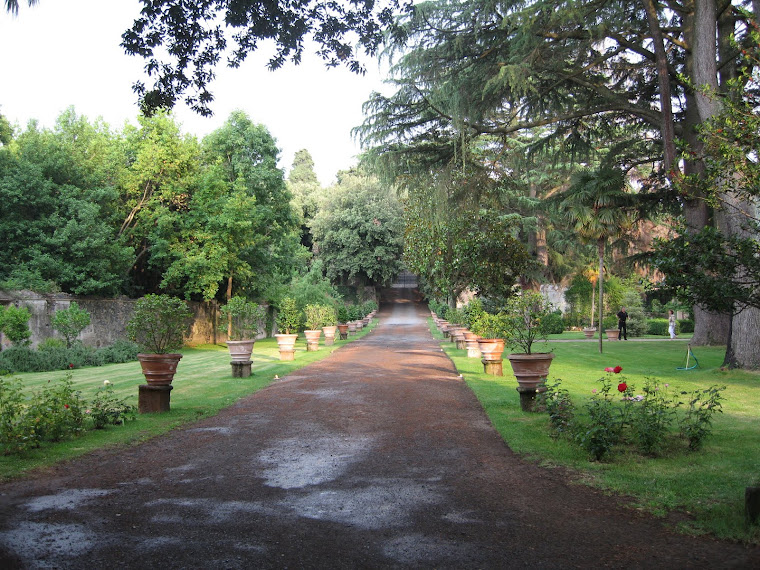
Our first stop was the Kaiser Wilhelm Memorial Church near our hotel. The interior walls of the newer memorial church are all stained glass. The old church was damaged in the war and isn't being repaired so as to preserve it as a ruin. Some of the stained glass from the old church was used in the new church. We had walked by several times but to that point had not gone in. Together they are called the "lipstick (the old church) and the powder puff (the new church)" or even the "rotten tooth."
We also learned that our nearest big street is called "Ku'Damm" by locals rather than the full Kurfurstendamm.
We saw a sculpture of a car crashed through concrete. On the way out of the city we went through the tree lined villa area. The main street is Koenigsallee. There was tombstone type monument for someone who was followed while driving in his convertible and shot three times by young Nazis during the period of the Weimar Republic. This was one of several political murders during that time. A lot of the murders were committed by secret Nazi organizations but blamed on Communists and the purpose was to create instability and discredit the Left.

As an aside, paper used to be made of old clothing and resulted in heavy paper used for special occasions. We passed Isadore Duncan's house. She died while driving when strangled by her elaborate long scarf.
We passed a villa on Erdener Strasse with a memorial to S. Fischer who had a publishing house. He died in 1934 and his family moved to California before the war. The plaque was put up by the family and they got the house back after the war but the building is now a multi-unit condominium. Many of the streets in the area now are named for former residents. The area is Grunewald (green forest) and is considered part of Berlin although it really is a suburb. During Communism it was surrounded by the wall as it is in the west. The area is close to a commuter train station. Just up the ramp was the embarkation point for trains going to the camps. There is a memorial to Mahnmal Gleis 17 (as most trains left from track 17). The Holocaust involved a lot of logistics-Eastern European Jews had to be killed first to make room in the ghettos and camps for the Western European Jews to come later. Plaques show how many were deported, on what date to what place (e.g., Riga, Lodz, Warsaw, Minsk, Theresienstadt). People lived within site of the station so one wonders what they thought. Alex says this was so because it wasn't a secret at all and was official policy that Jews were being evacuated as enemies of the state.

It's interesting that we were at Terezin and now see the embarkation point to that place for many Jewish Berliners. In some cases a place like Terezin (Theresienstadt) was just a connecting point or hub and people were transferred immediately to another location such as Auschwitz. As we progressed chronologically through the dates the numbers increased from 100 to 1,000+ people and also Auschwitz appeared as a direct non-stop destination. The last plaque shows only 18 Jews being deported to Theresienstadt on March 27, 1945. There are three more blank ones installed in case other transports come to light that also should be commemorated.

Clearly today will be about more than palaces and gardens. We also will be stopping at Wannsee where a conference was held in 1941 to plan the logistics regarding precisely how to exterminate the 11 million Jews of Europe. Alex said that as Hitler realized that the war was lost he still took great satisfaction that he nonetheless successfully had struck such an enormous blow against what he called "international Jewry."

No comments:
Post a Comment